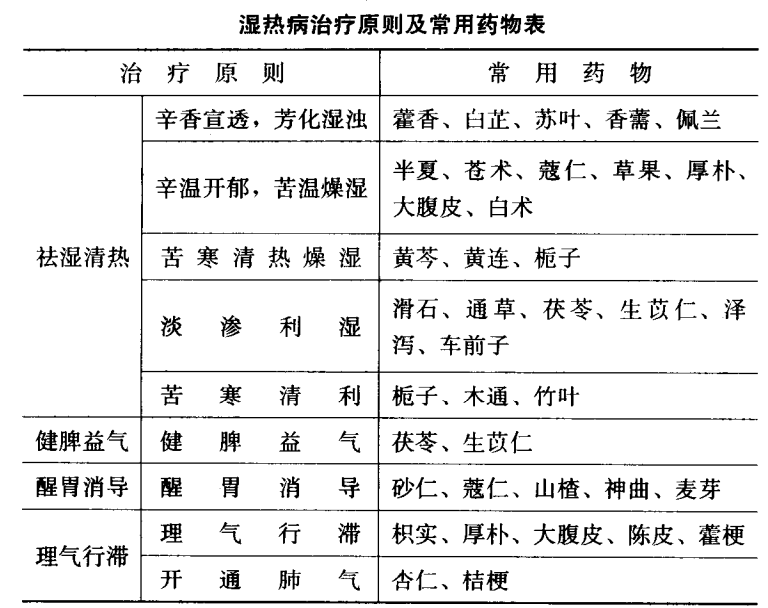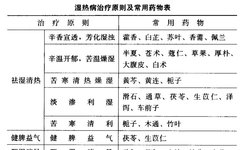

Damp-heat diseases are caused by the simultaneous invasion of dampness and heat into the human body, thus their treatment should focus on expelling dampness and clearing heat. However, since dampness and heat are combined, and heat exists within dampness, if dampness is not expelled, heat cannot be cleared. Therefore, the treatment should primarily focus on expelling dampness.Damp-heat pathogens can easily spread throughout the San Jiao (Three Burners), and the affected areas can be quite extensive, but the center of the disease may differ at various stages of development.In treatment, it is also necessary to target the center of the disease and select appropriate medications to expel damp-heat pathogens. Generally, there are four common methods to expel dampness and clear heat, which are described as follows:
1
Spicy and aromatic to disperse and transform dampness:This method is suitable for symptoms of damp-heat in the upper burner. It uses spicy and aromatic substances that are light and dispersive to promote lung qi and open the skin pores, allowing for slight sweating to release dampness through perspiration. Commonly used herbs include: Huo Xiang (Agastache), Bai Zhi (Angelica dahurica), Su Ye (Perilla leaf), Xiang Ru (Elsholtzia), Pei Lan (Eupatorium), etc. As Wu Ju Tong said: “Treat the upper burner as if it were a feather; it must be light to lift.” (Wen Bing Tiao Bian)
2
Spicy-warm to open and bitter-warm to dry dampness:This method is suitable for symptoms where dampness is heavier than heat in the middle burner. It combines spicy warm herbs with bitter warm herbs to open and descend, drying dampness and regulating the spleen and stomach to achieve balance. Commonly used herbs include: Ban Xia (Pinellia), Cang Zhu (Atractylodes), Dou Kou (Cardamom), Cao Guo (Tsaoko), Hou Po (Magnolia bark), Da Fu Pi (Areca peel), Bai Zhu (Atractylodes), etc. As Wu Ju Tong said: “Treat the middle burner as if it were a scale; it must be balanced to be stable.” (Wen Bing Tiao Bian)
3
Bitter-cold to clear heat and dry dampness:This method is suitable for symptoms where heat is heavier than dampness in the middle burner. It selects bitter-cold substances to achieve the goal of clearing heat and drying dampness. Commonly used herbs include: Huang Qin (Scutellaria), Huang Lian (Coptis), Zhi Zi (Gardenia), etc. Caution should be taken when using bitter-cold herbs for damp-heat diseases; they should only be applied when heat is indeed heavier than dampness. If dampness is heavier than heat, spicy-warm and bitter-warm herbs should be used to dry dampness. Misuse of bitter-cold herbs may not only fail to expel dampness but also lead to stagnation, making the condition difficult to resolve. If damp-heat is balanced, a combination of spicy-warm, bitter-warm, and bitter-cold herbs can be used.
4
Light diuretics to drain dampness:This method is suitable for symptoms of damp-heat in the lower burner. It uses light diuretic herbs to drain dampness and allow damp-heat to be expelled through urination. Commonly used herbs include: Hua Shi (Talc), Tong Cao (Tetrapanax), Fu Ling (Poria), Sheng Yi Ren (Job’s tears), Ze Xie (Alisma), Zhu Ling (Polyporus), Che Qian Zi (Plantago seed), etc. If heat is predominant, bitter-cold herbs that drain fire and open the water pathways can be added, such as: Zhi Zi (Gardenia), Mu Tong (Akebia), Zhu Ye (Bamboo leaf), etc. In summary, when treating lower burner damp-heat symptoms, it is essential to emphasize the use of draining and diuretic herbs to allow heavy and turbid dampness to settle down and be expelled. Damp-heat pathogens can easily spread throughout the San Jiao, affecting not only the center of the disease but also other areas. Therefore, in addition to targeting the center of the disease, it is also necessary to consider other areas to facilitate the expulsion of the damp-heat that has spread throughout the San Jiao. For example, in cases of upper burner damp-heat symptoms, in addition to experiencing chills, fever, and heaviness in the head and body, one may also see symptoms in the middle and lower burners such as chest tightness, poor appetite, and difficulty urinating.In treatment, the focus should be on spicy-warm dispersing and aromatic transforming dampness, while also appropriately combining spicy opening, bitter descending, and light diuretic herbs to address the middle and lower burners.In conclusion, when treating dampness, it is essential to consider all areas of the San Jiao, primarily focusing on dispersing and draining to ensure smooth flow throughout the San Jiao.The spleen governs the transformation and transportation of water and dampness, and in damp-heat diseases, dampness can easily obstruct the spleen and stomach, affecting their function. Therefore, when treating damp-heat diseases, it is common to include herbs that strengthen the spleen and benefit qi, as well as awaken the stomach and promote digestion, to enhance the transformation and transportation of water and dampness. Such herbs include: Fu Ling (Poria), Sheng Yi Ren (Job’s tears), Sha Ren (Amomum), Dou Kou (Cardamom), Shan Zha (Hawthorn), Shen Qu (Malt), Mai Ya (Barley sprout), etc.Dampness is heavy and turbid, easily obstructing the flow of qi. When qi is stagnant, the water pathways become blocked, making it difficult to expel dampness. Therefore, in treating damp-heat diseases, it is also necessary to appropriately combine herbs that regulate qi and relieve stagnation to promote the smooth flow of qi, or to add herbs that open lung qi to facilitate the regulation of water pathways. Such herbs include: Zhi Shi (Bitter orange), Hou Po (Magnolia bark), Da Fu Pi (Areca peel), Chen Pi (Aged tangerine peel), Huo Xiang (Agastache), Xing Ren (Apricot kernel), Jie Geng (Platycodon), etc.Here, the principles of treating damp-heat diseases and commonly used herbs are summarized in a table as follows:
Damp-heat pathogens can easily spread throughout the San Jiao, affecting not only the center of the disease but also other areas. Therefore, in addition to targeting the center of the disease, it is also necessary to consider other areas to facilitate the expulsion of the damp-heat that has spread throughout the San Jiao. For example, in cases of upper burner damp-heat symptoms, in addition to experiencing chills, fever, and heaviness in the head and body, one may also see symptoms in the middle and lower burners such as chest tightness, poor appetite, and difficulty urinating.In treatment, the focus should be on spicy-warm dispersing and aromatic transforming dampness, while also appropriately combining spicy opening, bitter descending, and light diuretic herbs to address the middle and lower burners.In conclusion, when treating dampness, it is essential to consider all areas of the San Jiao, primarily focusing on dispersing and draining to ensure smooth flow throughout the San Jiao.The spleen governs the transformation and transportation of water and dampness, and in damp-heat diseases, dampness can easily obstruct the spleen and stomach, affecting their function. Therefore, when treating damp-heat diseases, it is common to include herbs that strengthen the spleen and benefit qi, as well as awaken the stomach and promote digestion, to enhance the transformation and transportation of water and dampness. Such herbs include: Fu Ling (Poria), Sheng Yi Ren (Job’s tears), Sha Ren (Amomum), Dou Kou (Cardamom), Shan Zha (Hawthorn), Shen Qu (Malt), Mai Ya (Barley sprout), etc.Dampness is heavy and turbid, easily obstructing the flow of qi. When qi is stagnant, the water pathways become blocked, making it difficult to expel dampness. Therefore, in treating damp-heat diseases, it is also necessary to appropriately combine herbs that regulate qi and relieve stagnation to promote the smooth flow of qi, or to add herbs that open lung qi to facilitate the regulation of water pathways. Such herbs include: Zhi Shi (Bitter orange), Hou Po (Magnolia bark), Da Fu Pi (Areca peel), Chen Pi (Aged tangerine peel), Huo Xiang (Agastache), Xing Ren (Apricot kernel), Jie Geng (Platycodon), etc.Here, the principles of treating damp-heat diseases and commonly used herbs are summarized in a table as follows:


Life is like a journey, and I am also a traveler.

If you like this article, please share it with your friends. For more information, please follow me!
Source:Wen Bing Zong Heng / Zhao Shao Qin et al. Beijing: People’s Health Publishing House, December 2006.

Click to share
Click to like
Click to view

